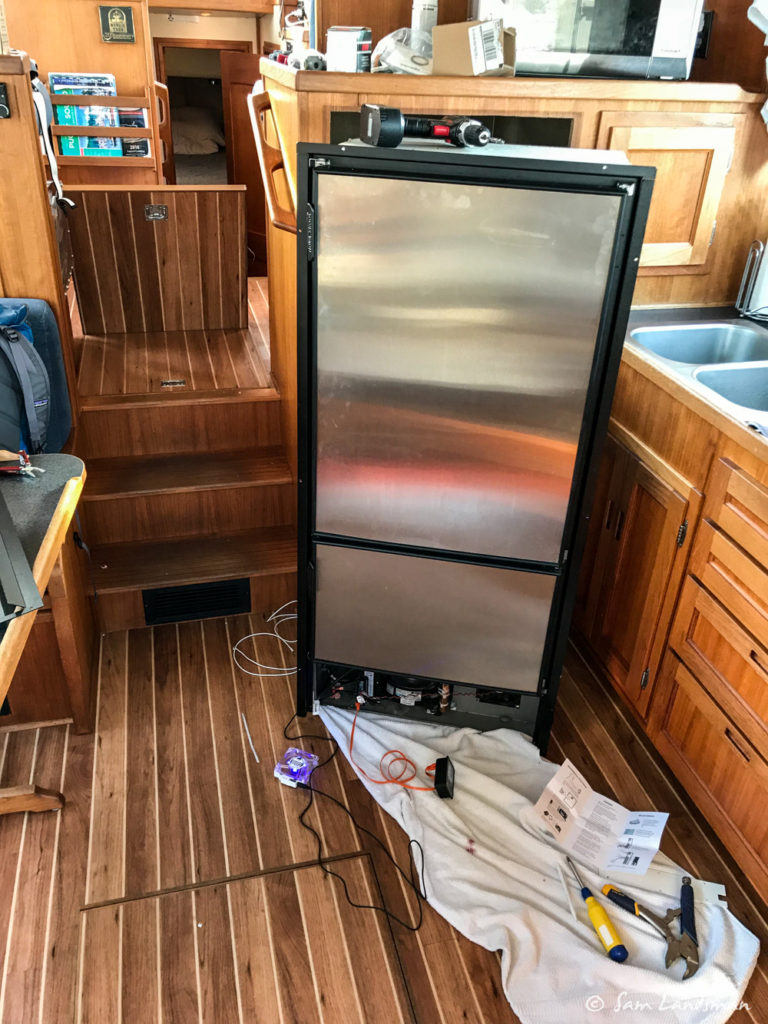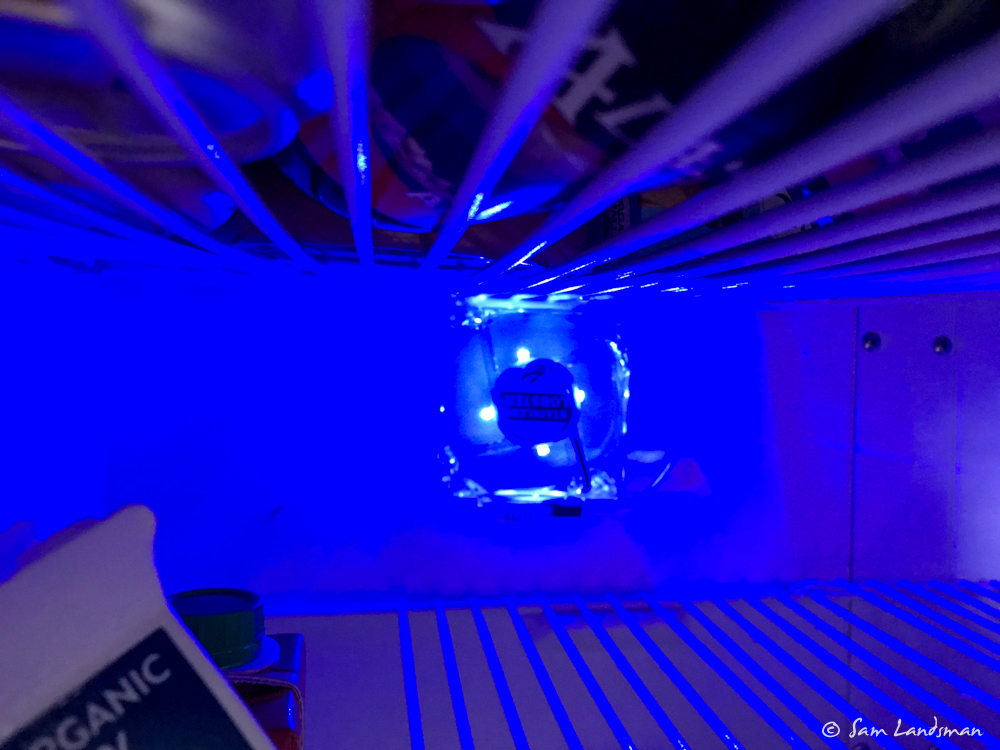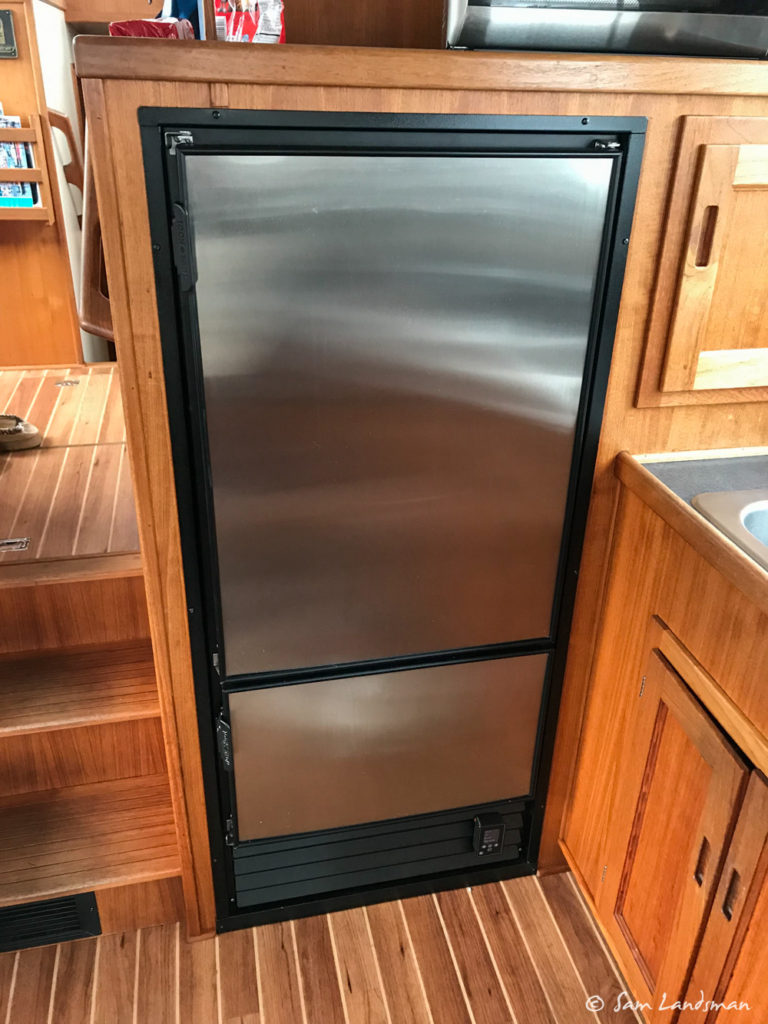Several years ago, I replaced the 15-year-old Norcold refrigerator aboard Safe Harbour with a shiny new NovaKool RFU9000. The new fridge reduced power consumption and was quieter, but it was far from perfect. In fact, it (along with the Force 10 range with the heat output of a Bic lighter) are among the most frustrating pieces of equipment onboard.
Temperature control in the NovaKool is, at best, imprecise. The rudimentary knob that controls temperature (mysteriously labeled not in useful units, like, say, degrees, but instead simply 1-8) has a tendency to get bumped, resulting in either puddle of water below the fridge and lots of warm food, or a fridge compartment so cold that the produce freezes solid. Ice built up on the cold plates rapidly, necessitating manual defrosting every few weeks. With no fan inside the fridge, air remained stagnant, with cold spots too cold (frozen food) and warm spots too warm (bad milk). Perhaps most annoying was the tendency of the compressor to cycle impossibly quickly, making unpleasant sounds, and occasionally ceasing to function entirely with no explainable reason (but always revived by giving a sharp whack to the controller).
A few months ago I stopped into Sure Marine to fill the propane and started chatting with the staff about the Stainless Lobster Fridge Optimizer.

I’d heard about this device for years, but never got around to installing it. It purports to solve many of the issues I’ve had by replacing the standard controller with the Fridge Optimizer. And the Fridge Optimizer is a big upgrade to the standard controller! It allows programming the set points for when the compressor turns on and off, in actual degrees (fahrenheit or celcius)! It shuts the compressor off for a preset length of time each day, allowing the ice built up on the cold plates to melt off! It adjusts the speed of the compressor depending on how much cooling is needed! It includes a fan to help air circulate inside the fridge to minimize warm and cold spots!

I bought one on the spot and dinghied back across the ship canal to install it.
Installation was generally easy, except for a small problem that gave me the opportunity to test Stainless Lobster’s customer service.
The Fridge Optimizer contains three major components: a fan with integrated thermometer and humidity sensor to go inside the fridge, a wiring block to plug into the the compressor, and a small display. A 3.5mm cable connects the wiring block to the fan/sensor. The most difficult part of the installation involved routing this cable. The included instructions recommend finding where the other wires go through the fridge and using the same hole. Unfortunately in my case, this hole was too small and had sharp edges. As I tried to feed the cable through, it snagged on jagged sheetmetal (awesome build quality NovaKool!) and the end sliced right off.

Stainless Lobster answered my call promptly and quickly dispatched a new cable to me, free of charge. Meanwhile, I began thinking about alternative cable routing ideas. My choices were to try to enlarge the existing hole (without damaging any existing wires) or drill a new hole. I quickly settled on the latter, and a few minutes later the job was done, thankfully without damaging any of the refrigerant lines.
The rest of the installation was quick and easy. The new wiring block fit perfectly and the half-dozen electrical connections went together readily. An ethernet cable connects the wiring block to the controller, and I chose to simply wedge the controller in the grill at the bottom of the fridge until a more permanent solution could be devised. All in, including pulling the fridge out of the cabinet and then putting it back in (to drill the hole and run the fan/sensor wire), installation took less than a couple hours.
So, how does it work after a few months of use?
Temperature control is much better. I have the fridge set to a low temperature of 33°F and a high temp of 37°F. So far, there’s been no frozen produce or spoiled milk!

The defrost works reasonably well, but it’s not perfect. It functions by shutting the compressor off for a set length of time every 24 hours (default is 40 minutes). The idea is to set this to a time that is short enough that it won’t allow the temperature of the fridge to spike dangerously high, but long enough that the ice melts off the cold plate.
The problem is the ice that melts off the cold plate doesn’t really have any place to go, and the water drips through the fridge. A sponge wedged below the cold plate contains this water for now (with periodic wringing in the sink), but I’m thinking a simple drain into a bottle is a better long-term solution.
The Fridge Optimizer has a few other tricks, too. It tracks compressor run time, fridge temperature, fridge humidity, power consumption, and more. It apparently reduces power consumption (I haven’t tested, and frankly don’t care).It allows you to set it to lower the temperature when the batteries are charging, which should reduce power consumption while at anchor.

I’ve been blown away by how much compressor run time varies. When the boat is sitting in its slip unattended (and unheated), the compressor sometimes runs less than an hour a day. Christmas Day, with five people aboard and lots of trips into the refrigerator, it ran nearly continuously, gobbling up more than 140 amp hours in a 24 hour period.
Probably the biggest shortcoming of the Fridge Optimizer is that it only impacts the fridge section of the fridge/freezer. Since the freezer section never gets above freezing (hopefully!), it doesn’t defrost automatically. And since the fan/sensor is in the fridge compartment, it provides no information about (or air circulation to) the freezer compartment.
Despite this shortcomings, the Fridge Optimizer improves the NovaKool in a big way. I just wish a new $2000 refrigerator didn’t need a $200 aftermarket controller to achieve decent performance.

